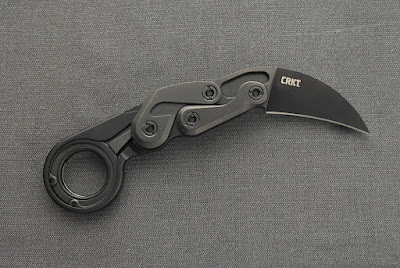A recent episode of the “The
Rookie’ shows one of the characters showing his last resort knife to his
training officer. It resembles a
Benchmade 175BK push dagger. It’s a
short story arc that helps support the longer main arc.
Still, one can see why real LEOs
will carry a last resort weapon. They
don’t have a room of script magicians to write them out of the problem. These weapons are usually very simple to
use. Any tool that requires year to
learn and five years to master will fall outside the definition of ‘tool-of-last-resort.’
Karambits have this tool
potential. The ordinary user can slip
his little finger onto the loop and hold it in a hammer fist and simply claw
his way out of danger trouble. Placing your
thumb on the back of curved spine will give you a little more feedback. Are we not trained to touching things with
our thumb? The same almost autonomic reflex helps guide the blade.
Held in the reverse grip, the
blade juts out of our fist like a prehistoric claw, perfectly situated for
close infighting moves. Small wonder folding karambits are so popular. Closed, they are easy to conceal, a basic
impact weapon and open, it becomes so much more.
In the hands of someone with more
training than I, the karambit has multiple applications. The dull spine can be used use to trap and
control opponent’s arms and balance, making a range of other physical responses
available. The razor edge lets you
transition from physical control to higher levels of force almost
instinctively.
Folding karambits have some
problems. Opening isn’t always easy and
fingers can get in the way of the edge.
Lock and pivot points wear and fail from applying load on the spine or
side of the blade. All knives direct the
load into the handle but the twisting load generated by using the blade as a
control device can cause handle failures.
 |
| CRKT's Provoke, designed for LEO and people in dangerous places |
Many of the devices used to open
the blade as you remove it from your pocket don’t assist you opening the
karambit if you are holding it in your hand as an impact tool.
CRKT has taken Joe Caswell’s
design and produced the Provoke. It is a unique knife that may change how
we open and close folding knives. Your fingers
are never in the path of the blade when opening or closing. The blade is firmly locked in place by two
stout arms.
 |
| The front of Joe Caswell's innovative folding karambit |
The problem is opening from the
pocket draw. The optimal opening has the
index finger through the ring and the dull spine against the palm of your
hand. The thumb presses the back pivot
point and the blade pops open.
 |
| Back side of the Provoke. The clip holds the knife deep in the pocket. What you see doesn't look like a clip. |
Here’s a right and left hand draw
with opening showing the finger movements I use. It looks clumsy when shone slowly to reveal
finger movement. It’s not. Practice for ten minutes and it will feel
completely natural to you.
Left side opening. I needed to pivot out of the camera view to show the opening. You really don't hold it like a soiled tea bag.
Right side opening. The knife must slide from the thumb to the index finger
It’s not an inexpensive knife and
has limited general application. Its cutting
edge design and manufacturing has built in a high degree of reliability. It is last-chance-tool to claw your way out
from under the casket lid.
Find yours at
https://www.crkt.com/provoke.html. MSRP is $200.00. Cheap at that price.

